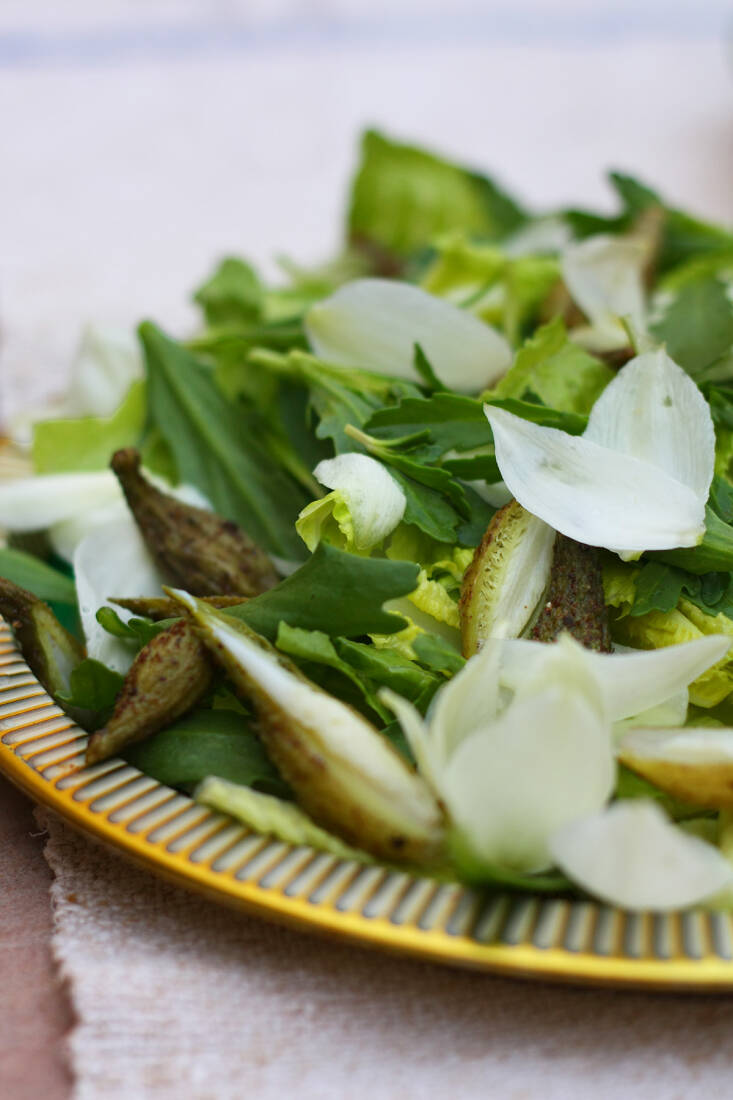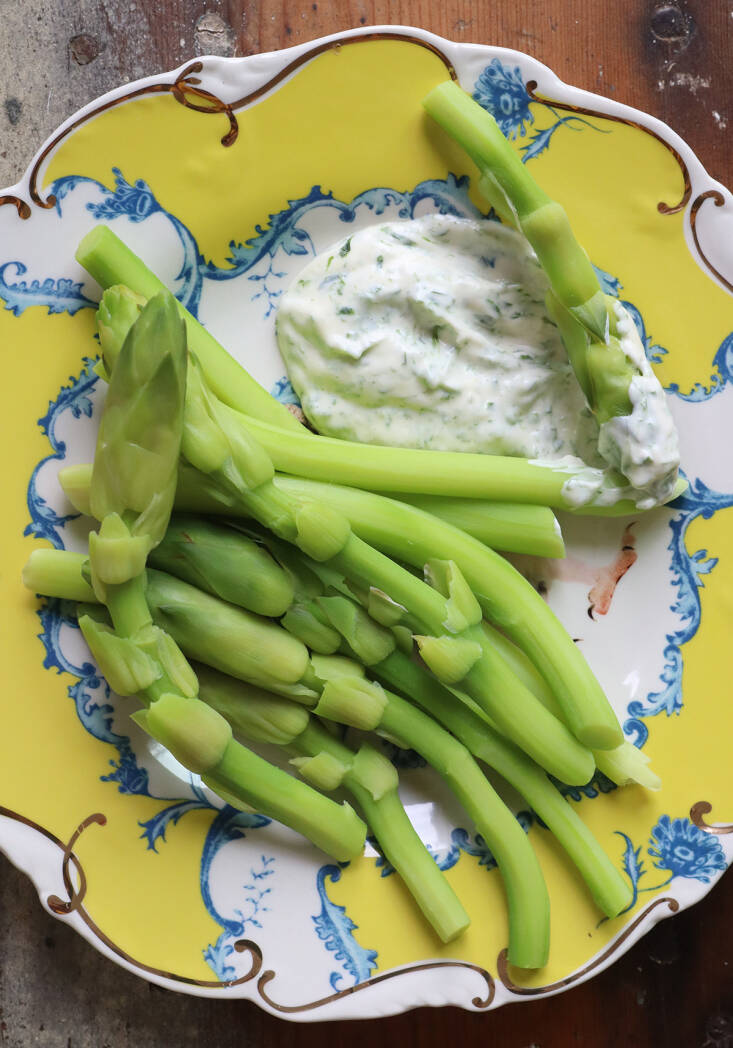There are a myriad criteria when selecting plants to populate a garden or cultivated landscape: resilience, form, texture, multi-seasonal interest in terms of foliage, flowers, and fruit—and, for kitchen gardeners, cooks, and backyard foragers, is it edible? As summer begins to assert itself, yucca, readying to display its statuesque floral appeal, is reminding us that it checks every box. And several more. The developing flowering stem of yucca resembles an enormous asparagus stalk, and when it branches into a multitude of buds, each plant is transformed into a luminous floral candelabra, loved by pollinators, hummingbirds, and humans.
Photography by Marie Viljoen.

Where I live in the Northeast, the regionally conspicuous yucca is Yucca filamentosa. It is used extensively in urban parks and public gardens and has spread to grow wild along shorelines, in old dunes, in pine barrens, and in sunny fields. Native to the Southeastern United States, this yucca has naturalized well beyond its native region. It is impressively hardy, down to USDA zone 4 (where it may need some protection from winter winds).

On the plant walks that I lead, it never fails to surprise people that this sharp plant is not a denizen of the desert (although it has many desert—as well as tropical—yucca relatives through the Americas).

The species—filamentosa—tells us something about the plant: it refers to the hair-like fibers that fray from each spiked leaf.


Despite growing happily in the rain-rich Northeast, Y. filamentosa has yet another quality to recommend it to horticulturists. It is water-wise. This is a resilient plant, requiring no additional irrigation once established. And there’s more: Those stabbing leaf-points are a natural deterrent where one might be needed, in public or private plantings; think of it as a botanical porcupine, or a living security plant. People (and deer!) keep their distance. There are other bonuses, for either the just-plain-curious or for the survival-obsessed: Yucca’s leaves provide cordage, and the dry flower stalks can help you make fire. It’s pounded root could help you poison and catch fish. It’s a plant for the apocalypse. But that’s another story…

Speaking of the root: In terms of eating yucca, there is a hurdle, and it is semantic: Yucca is not yuca.
Yuca (also called cassava and manioc) is the tuber of the tropical Manihot esculenta. It is sold in the produce section of many groceries. It is sometimes also spelled yucca, which can confuse matters for people still learning to speak Plant.

Most sources cite the open blooms and the unripe seedpods of yucca as the main food-parts of the plants. The flower petals taste mild, like tender iceberg lettuce, as long as the bitter reproductive parts are removed. They are eaten traditionally after boiling and cooking, but I prefer their sparing use in salad.



If you catch them while they are still tender, yucca’s green, unripe seedpods are an interesting vegetable.

To be eaten, yucca pods must be juicy inside, the seeds white and soft and immature, and all traces of green skin peeled off, or the pods are inedibly bitter. They should then be cooked, or blanched and pickled.


And while the flowers and pods are fine to eat, yucca produces early summer’s exceptional seasonal delicacy: that tender, asparagus-luscious stem. Just over a decade ago, a dip into one of my plant bibles (whose price has since turned stratospheric), Native American Food Plants, An Ethnobotanical Dictionary, compiled by Daniel Moerman, gave me a tantalizing clue: Y. whipplei stalks (even fatter than filamentosa’s) were cooked and eaten by several Native American nations. I eyed the next early summer’s yucca stalks very appreciatively. They really did look like fat asparagus. Which makes sense because, wait for it, yuccas belong to Asparagaceae family.
Since then, a modest-sized treat of cooked yucca shoots (which is how I refer to these apical meristems), has been an early summer ritual. They have the texture of asparagus, a distinct sweetness, and a unique flavor of their own.

Like asparagus, edible yucca stalks should be snappable. This indicates that they are still actively growing and very tender.






Once they are prepared and blanched until tender, yucca shoots are versatile. Make old-fashioned, new-fashioned tea sandwiches by layering yucca shoots with mayo and egg in sandos, on shokupan (Japanese milk bread. (Or, while you’re waiting for the special bread pans that you ordered to bake shokupan to arrive, substitute un-ironic Wonderbread!)

Marinated Chicken and Yucca Shoot Salad
Serves 2
Use leftover roast chicken to toss together this brightly tangy summer salad (or poach and cool a couple of skinless thighs). If the yucca shoots have already developed a leafy bract under individual clusters of buds on each stalk, those bracts will be bitter – after blanching, pull them off and discard
- 3 yucca shoots (immature flowering stalks), washed, lower stems peeled
- 2 Tablespoons white wine vinegar
- 1 Tablespoon sugar
- 2 teaspoons sumac
- 1/8 teaspoon salt
- Freshly-ground black pepper, lots
- 1 small red onion, very thinly sliced
- 2 cups shredded, cooked chicken
- 6 boiled baby potatoes, cut into bite-sized pieces
- 3 Tablespoons extra virgin olive oil
- 8 mint leaves, slivered
For the yucca shoots: Bring a pot of water to a boil and drop the shoots into it. Boil for 4 – 5 minutes. The shoots should be tender when pierced with a knife at the thickest part. Drain, refresh in cold water, and roll dry in a clean kitchen towel. Cut the yucca into bite-size pieces.
For the vinaigrette: In a small bowl mix together the vinegar, sugar, salt, sumac, and pepper, and stir until the sugar and salt have dissolved. Add the onions and stir well. Leave for at least 5 minutes to macerate.
To assemble: In a larger bowl toss together the chicken, potato, and onion, then add the cooked yucca. Finally, drizzle the oil over the mixture, and add the fresh mint. Toss gently one more time. It is ready.
See also:
- Gardening 101: Yuccas
- June Is Serviceberry Season! Here’s How to Use the Foraged Fruit for Sweet Treats
- 11 Favorites: Edible Flowers of Spring












Have a Question or Comment About This Post?
Join the conversation